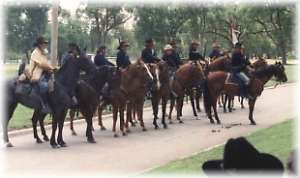Historic Fort Supply
category : Historic Forts
 Five remaining buildings from the army-era at Fort Supply have been restored to their appearance of over 100 years ago, and are listed on the National Register of Historic Places.
Five remaining buildings from the army-era at Fort Supply have been restored to their appearance of over 100 years ago, and are listed on the National Register of Historic Places.The Visitor Center is located just west of the old Guardhouse and contains exhibits telling the forts story through artifacts, photographs, and graphics.
An annual Living History Day is held each June. This colorful celebration allows visitors to experience Oklahoma history through reenactors portraying the lives of the people of Fort Supply's past.
About Fort Supply ...
Historic Fort Supply was established on November 18, 1868, as "Camp of Supply" for a winter campaign against the Southern Plains tribes in what is now western Oklahoma. From this post, Lt. Col. George Armstrong Custer and the Seventh U.S. Cavalry marched south to the Washita river Valley and attacked the Cheyenne village of Chief Black Kettle. This event marked the beginning of the end for the Southern Plains tribe's nomadic way of life because they were soon forced onto reservations.
The military presence in the region was felt for the next twenty-five years as troops from the post performed peace-keeping duties monitoring the Cheyenne and Arapaho reservation. Camp Supply was the site of the first Cheyenne-Arapaho Agency in 1869-1970. Soldiers patrolled the Cheyenne-Arapaho Reservation and the Cherokee Outlet in an effort to contain the tribesmen and keep out trespassers. buffalo hunter, timber and horse thieves, whiskey peddlers, and "Boomers" were a continual threat to stability in the Indian Territory.
The post served as the supply point for the Red River War of 1874-1875. This was the final struggle in the subjugation of the tribes of the Southern Plains. The unsuccessful attempts to stop the flight of the Northern Cheyenne from their reservation in Indian Territory, known as the Dull Knife Outbreak of 1878, were the last engagements between Indians and soldiers from Camp Supply.
Cavalry policed the cattle drives along the Western Trail as they made their way through the territory from Texas to Dodge City, Kansas. They later policed the large grazing leases that cattlemen held on the lands of the Cherokee Outlet and the Cheyenne and Arapaho Reservation.
When Camp Supply became Fort Supply in December, 1878, the post had already become the hub of transportation and communication in a region which included southern Kansas, the Texas Panhandle, and Indian Territory. Troops built the roads and telegraph lines that linked the forts, reservations, and settlements. They guarded the stage coaches, freight haulers, and travelers as they moved along the trails.
The Run of 1893 opened the lands of the Cherokee Outlet to non-Indian settlement. The troops at Fort Supply policed that operation, which proved to be the last major task for the soldiers at Fort Supply.
The frontier was closing and the presence of the army was no longer required. In late 1894, the post was abandoned and the property turned over to the Department of the Interior.
Admission: Free Admission
Phone: 580-766-3767
Fort Supply Historic Site
P.O. Box 247, U.S. Highway 270
Fort Supply, OK 73841
Come visit us in Oklahoma, Oklahoma